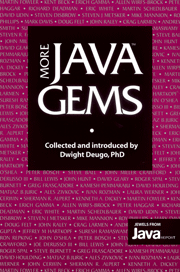Book contents
- Frontmatter
- Contents
- INTRODUCTION
- GETTING STARTED WITH JAVA
- MIGRATING TO JAVA
- TECHNIQUES 101
- MODELING AND PATTERNS
- JAVA IN A DISTRIBUTED WORLD
- MOBILE AGENT SYSTEM ARCHITECTURE
- DEPLOYMENT STRATEGIES FOR JAVA CLIENT APPLICATIONS
- LOCATING CORBA OBJECTS FROM JAVA
- THREADS
- USER INTERFACES
- SECURITY
- TESTING
- PERFORMANCE
- REALITY CHECK
- INDEX
MOBILE AGENT SYSTEM ARCHITECTURE
Published online by Cambridge University Press: 06 July 2010
- Frontmatter
- Contents
- INTRODUCTION
- GETTING STARTED WITH JAVA
- MIGRATING TO JAVA
- TECHNIQUES 101
- MODELING AND PATTERNS
- JAVA IN A DISTRIBUTED WORLD
- MOBILE AGENT SYSTEM ARCHITECTURE
- DEPLOYMENT STRATEGIES FOR JAVA CLIENT APPLICATIONS
- LOCATING CORBA OBJECTS FROM JAVA
- THREADS
- USER INTERFACES
- SECURITY
- TESTING
- PERFORMANCE
- REALITY CHECK
- INDEX
Summary
You have probably heard or read something about software agents; they have been a hot topic for some time now and agent-based commercial products are available. There are several schools of thought on what the term “agent” really means. For example, in the context of artificial intelligence, an agent is often described as an autonomous, intelligent entity: They can make decisions and perform actions based on perceived inputs in order to achieve some goal (Russell, S., and P. Norvig, Artificial Intelligence: A Modern Approach, 1995).
Mobility is a common characteristic of many agent definitions. A mobileagent is an active object that can move both data and functionality (code) to multiple places within a distributed system. It doesn't matter what the ultimate purpose of the agent is or whether or not it can be classified as “intelligent.”
A mobile agent should be able to execute on any machine within a network, regardless of the processor type or operating system. In addition, the agent code should not have to be installed on every machine that the agent could potentially visit; it should move with the agent's data automatically. Therefore, it is desirable to implement agents on top of a mobile code system, such as Java virtual machine (VM). The dynamic nature of Java classes and objects, combined with advanced networking capabilities, makes Java highly qualified for use as a mobile agent platform.
- Type
- Chapter
- Information
- More Java Gems , pp. 169 - 178Publisher: Cambridge University PressPrint publication year: 2000
- 1
- Cited by



